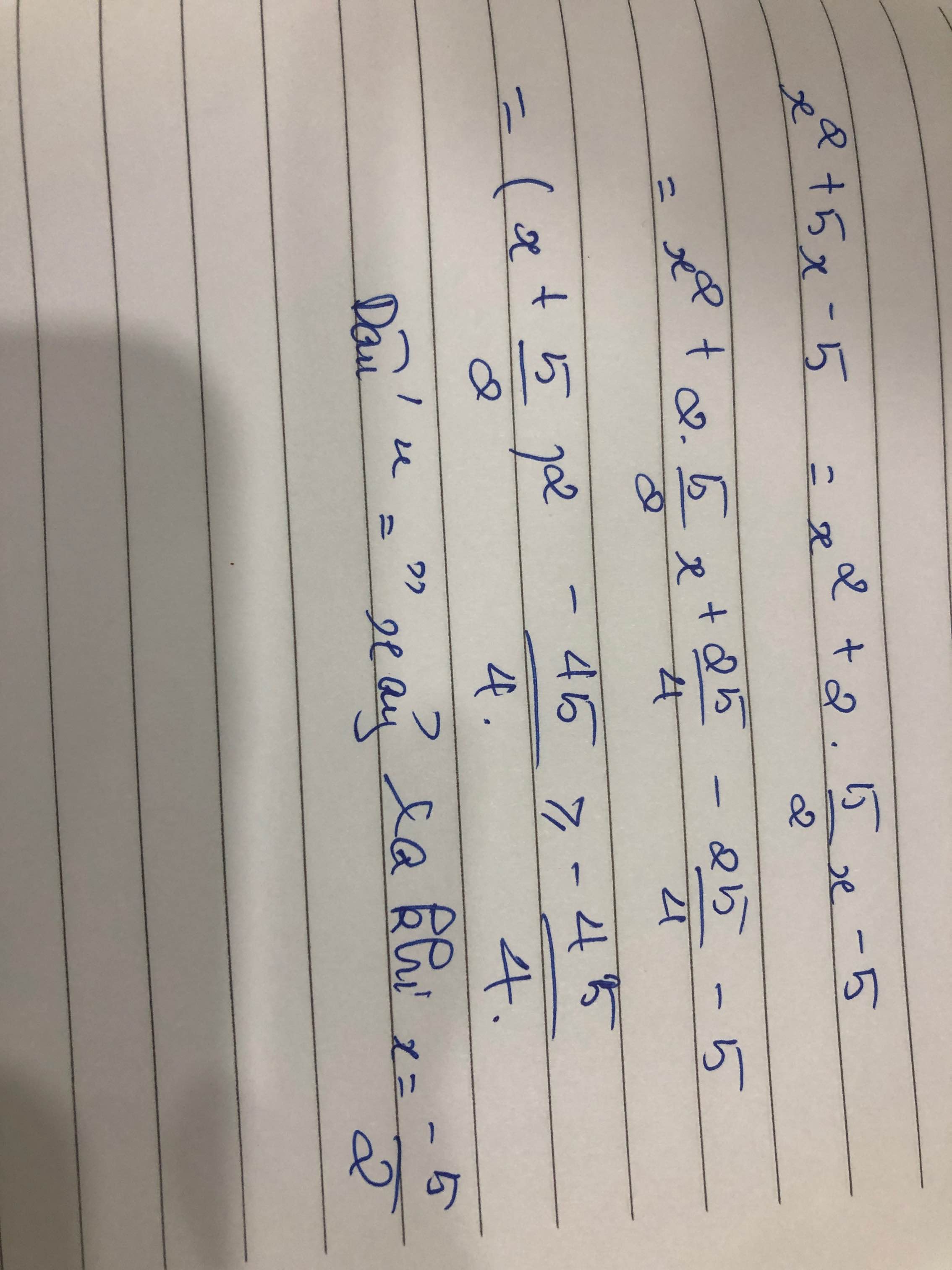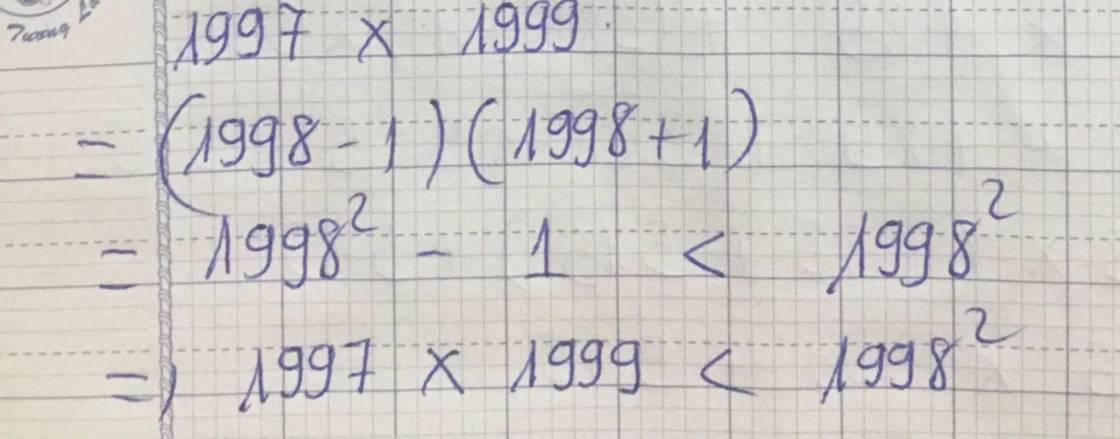
Hãy nhập câu hỏi của bạn vào đây, nếu là tài khoản VIP, bạn sẽ được ưu tiên trả lời.


A = x2 + 5x - 5
A = x2 + 2. \(\dfrac{5}{2}\) x + ( \(\dfrac{5}{2}\))2 - \(\dfrac{45}{4}\)
A = (x + \(\dfrac{5}{2}\))2 - \(\dfrac{45}{4}\)
(x + \(\dfrac{5}{2}\))2 ≥ 0 ⇔ A = (x + \(\dfrac{5}{2}\))2 - \(\dfrac{45}{4}\) ≥ \(\dfrac{-45}{4}\)
A(min) = -45/4 = xảy ra ⇔ x + 5/2 = 0 ⇔ x = -5/2

ĐKXĐ: \(x\ne1;x\ne2\)
\(\dfrac{4}{x-1}-\dfrac{5}{x-2}=-3\)
\(\Leftrightarrow\dfrac{4\left(x-2\right)-5\left(x-1\right)}{\left(x-1\right)\left(x-2\right)}=\dfrac{-3\left(x-1\right)\left(x-2\right)}{\left(x-1\right)\left(x-2\right)}\)
\(\Rightarrow4x-8-5x+5=-3x^2+6x+3x-6\)
\(\Leftrightarrow3x^2-10x+3=0\)
\(\Leftrightarrow\left[{}\begin{matrix}x=3\\x=\dfrac{1}{3}\end{matrix}\right.\)(TM)
Vậy...
= 4/x - 5/x - 1 - 2 = -3
= \(\dfrac{4-5}{x}\) - 3 = -3
=> -1/x = 0
=> x = -1 : 0
=> x ko có gtr thỏa mãn

Em nên gõ công thức trực quan để được hỗ trợ tốt hơn nhé


\(A=1997.1999=\left(1998-1\right)\left(1998+1\right)=1998^2-1< 1998^2=B\)

I'll let you do the drawing.
a) Consider the 2 triangles AHM and ABH, which both have a common angle at A, have \(\widehat{AMH}=\widehat{AHB}\left(=90^o\right)\). Therefore, \(\Delta AHM~\Delta ABH\left(a.a\right)\). This means \(\dfrac{AH}{AB}=\dfrac{AM}{AH}\) or \(AH^2=AM.AB\)
Similarly, we have \(AH^2=AN.AC\). From these, we get \(AM.AB=AN.AC=AH^2\)
We can easily prove that AMHN is a rectangle (because \(\widehat{MAN}=\widehat{AMH}=\widehat{ANH}=90^o\)). Thus, \(AH=MN\)(2 diagonals of a rectangle are equal)
And finally, we get \(AM.AB=AN.AC=MN^2\), and that's what we must prove!
b) We can easily prove \(HN//AB\left(\perp AC\right)\), which means \(\widehat{FHN}=\widehat{B}\)
Consider the right triangle BHM (right at M), it has the median ME. Therefore, \(ME=\dfrac{BH}{2}\). We also have \(BE=\dfrac{BH}{2}\) so \(ME=BE\) or \(\Delta BEM\) is an isosceles triangle, or \(\widehat{BEM}=180^o-2.\widehat{B}\)
Similarly, we have \(\widehat{HFN}=180^o-2.\widehat{FHN}\)
We have already had \(\widehat{B}=\widehat{FHN}\). Thus, \(\widehat{BEM}=\widehat{HFN}\) or \(ME//NF\) (2 equal staggered angles)
Therefore, MEFN is a trapezoid.
In this trapezoid, I is the midmpoint of EF, O is the midpoint of MN (2 diagonal AH, MN of the rectangle AMHN meets at O). Thus, OI is the avergage line of the trapezoid MEFN (ME//NF) or \(OI//NF\)
It's easy to see \(\widehat{FNC}=\widehat{C}\); \(\widehat{MNH}=\widehat{MAH}\)
Also, \(\widehat{C}=\widehat{MAH}\left(=90^o-\widehat{B}\right)\). So, \(\widehat{FNC}=\widehat{MNH}\) or \(\widehat{FNC}+\widehat{FNH}=\widehat{MNH}+\widehat{FNH}\) or \(\widehat{CNH}=\widehat{MNF}\). Because \(\widehat{CNH}=90^o\), it's easy to see \(\widehat{MNF}=90^o\) or \(NF\perp MN\)
We have already prove that \(OI//NF\). Therefore, \(OI\perp MN\), and that's what we must prove!
c) I'm thinking about this question.

cái này đáng ra là tìm giá trị lớn nhất chứ không phải nhỏ nhất
p = 2 + x - x2
P = -x2 + x + 2
P = - ( x2 - 2. \(\dfrac{1}{2}\)x + \(\dfrac{1}{4}\)) + \(\dfrac{9}{4}\)
P = - (x - \(\dfrac{1}{2}\))2 + \(\dfrac{9}{4}\)
- ( x - 1/2 ) 2 ≤ 0 ⇔ p ≤ \(\dfrac{9}{4}\)⇔ P(max) = 9/4 dấu = xảy ra khi x = 1/2

